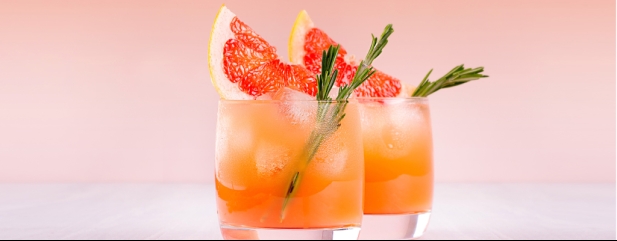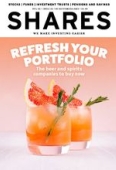Archived article
Please note that tax, investment, pension and ISA rules can change and the information and any views contained in this article may now be inaccurate.
Discover the best stocks for exposure to the beer, wine and spirits business

Persistent inflation and higher interest rates are squeezing disposable incomes. In this scenario there is logic in investors putting their cash behind companies which make premium products which confer pricing power or sell affordable luxuries which help consumers to socialise or unwind at the end of the working day.
One sector that enjoys both these attributes is Beverages, the domain of soft drinks companies but also distillers and vintners, those producers of high-end spirits, beers and wines which can boast palate-pleasing strategic attractions.
Their appeal is underscored by the takeovers of SABMiller by Anheuser-Busch Inbev (BUD:NYSE), the 2016 deal which brought together the world’s two largest brewing empires, and of spirits-to-liqueurs business Stock Spirits by private equity outfit CVC in 2021.
Despite global economic uncertainties, the major spirits and beer producers continue to exhibit resilience, confounding fears hard-pressed drinkers will trade down to cheaper alternatives amid the cost-of-living squeeze.
This is thanks to strong brands that engender loyalty and trends towards premiumisation in the fragmented global drinks market.
There are three sub-divisions of the alcoholic beverages industry: beer, wine and spirits. Traditionally spirits stocks have traded on higher valuations than brewers or wine producers because of their superior growth prospects driven by rising Western consumption and increased emerging market affluence and the earnings quality conferred by their brands and pricing power.
People buy wine by the grape variety not the name on the bottle, in contrast to spirits where no-one cares about the juniper or grain and the brand is key. Crop failure or a glut can also hurt wine growers.
But this makes little odds to spirits firms, whose products are low cost to make and command high selling prices. Beer makers benefit from brand strength and predictable demand, though their growth tends to be low as the worldwide beer market is highly developed.
According to drinks market analysis firm The IWSR, over the past five years the total beverage alcohol market has grown at a 4% compound annual growth rate (CAGR) by retail sales value, with spirits growing faster at a 6% CAGR.
Geopolitical and economic turbulence is leading alcohol drinkers to shift consumption behaviours, but major drinks firms are benefiting from premiumisation, the trend which sees consumers drinking less but spending more on premium tipples, whilst delivering pockets of growth in craft beers and low and zero alcohol products.
WHAT ARE THE IMPORTANT METRICS TO FOCUS ON?
Key metrics to study with beverages companies include organic sales and volume growth, indicators of rising or falling demand for their drinks, and also gross margin, calculated by dividing gross profit by revenue and multiplying the figure by 100 to get a percentage.
High gross margin drinks companies have more of a buffer to handle rising raw materials costs. Other sector metrics worth monitoring include free cash flow, a measure favoured by famous investors including Warren Buffett and Terry Smith, and return on capital employed (ROCE).
WHICH COMPANIES ARE LISTED ON THE STOCK MARKET?
London-listed options include Diageo (DGE), the drinks giant behind iconic alcoholic beverage names including Johnnie Walker, Smirnoff and Guinness as well as Captain Morgan rum and Tanqueray premium gin. Led by CEO Debra Crew, a recent successor to the late Ivan Menezes, the £73.3 billion cap boasts over 200 brands and sells in nearly 180 countries.
It has a worldwide distribution footprint and massive marketing clout. It also owns ‘Local stars’ such as Crown Royal, Buchanan’s and Chinese white spirit Shui Jing Fang and a ‘Reserve’ portfolio of global luxury market-focused labels including Ketel One and Cîroc vodka and acquired tequila brands Don Julio and Casamigos.
Despite its status as the leading international spirits player, there is still plenty of global growth for Diageo to go for and the free cash flow monster is a source of progressive dividends and bumper buybacks. However, the share price has soured of late amid concerns over falling US spirits sales and declining sales in China.
Lower down the market cap scale is C&C (CCR), the maker of cider brands Magners, Bulmers and Orchard Pig as well as beer brand Tennent’s, though the cost-of-living crisis and rail strikes have impacted earnings and C&C’s shares remain in the doghouse following a recent technology project debacle.
The premiumisation trend is a driver for June 2021 IPO and online premium whisky purveyor Artisanal Spirits (ART:AIM). This company owns The Scotch Malt Whisky Society and the J.G. Thompson brand and has minimal market shares in all its territories, which means Artisanal has a substantial global growth opportunity if it can get the execution right.
Companies participating in the English wine sector include Gusbourne (GUS:AIM), a currently loss-making producer and distributor of high-quality vintage English sparkling wines from grapes grown in its own vineyards in Kent and West Sussex, and Chapel Down, England’s largest winemaker which is listed on the Aquis Exchange.
ARE THERE RELEVANT STOCKS OVERSEAS?
Another name exposed to the premiumisation theme is Diageo’s smaller spirits rival Pernod Ricard (RI:EPA), the world’s number two wines and spirits producer whose portfolio spans everything from Absolut Vodka and Ricard pastis to Chivas Regal and The Glenlivet Scotch whiskies, Martell cognac, Havana Club rum, Jacob’s Creek wine and Perrier- Jouët champagne.
Overseas options in beer include the aforementioned Budweiser-to-Stella Artois owner Anheuser-Busch Inbev. Though the stock is still recovering from a consumer boycott of its Bud Light brand following a backlash over its social media promotion with transgender influencer Dylan Mulvaney.
The rumpus benefited smaller rival Constellation Brands (STZ:NYSE), the company behind Corona beer, Casa Noble tequila and wine brand Meiomi, whose Modelo Especial Mexican lager brand subsequently leapfrogged Bud Light to become the top-selling US beer brand.
European firms include Dutch brewing group Heineken (HEIA:AMS), a running Great Ideas pick offering exposure to internationally renowned brands including the eponymous one as well as Amstel, Moretti, Sol and Tiger. Heineken is the world’s most valuable and most-trusted beer brand, but the parent company also owns dozens of well-loved craft beer and cider products.
Another leading operator is Danish brewer Carlsberg (CARL-B:CPH), which shrugged off cost inflation and the squeeze on drinkers’ disposable incomes to deliver a ‘solid’ performance for the first half to 30 June, giving management the confidence to raise its 2023 earnings forecast.
Operating profit bubbled up 5.2% in the period as drinkers gulped down Carlsberg’s premium brands including the namesake lager, Tuborg, 1664 Blanc, Brooklyn and Somersby, and the group enjoyed continued growth in key Asian markets.
CAN I PLAY THE THEME THROUGH FUNDS?
Funds invested in major drinks names, admittedly part of diversified portfolios, include Terry Smith’s Fundsmith Equity Fund (B41YBW7), which holds Brown-Forman (BF.B:NYSE), the American-owned spirits and wines company best-known for Jack Daniel’s. Brown-Forman has historically generated a high return on capital employed north of 20% which clearly appeals to Smith.
Heineken and Diageo represent 4.1% and 4% of the assets of the Evenlode Global Equity (BMFX289) fund and are positions in Nick Train’s Finsbury Growth & Income Trust (FGT) which also holds cognac and liqueur maker Remy Cointreau (RCO:EPA).
TWO STOCKS TO BUY
Heineken (HEIA:AMS) €90.50
Recent first-half results (31 July) from Heineken came in short of expectations and a downgrade to full year operating profit guidance from mid to high-single digit growth to flat to mid-single digit growth was disappointing.
Yet Shares remains positive on the Dutch brewing group, which trades on a forward price to earnings ratio of 18 that is cheap relative to history and is gradually restoring dividend levels after suspending them during the pandemic.
Heineken has finally sold off its Russian beer business, albeit at a loss, removing an overhang on the stock, while price increases are expected to moderate for the rest of the year which should have a positive effect on volumes.
As Nick Train reminded investors in Finsbury Growth & Income’s half year results review, Heineken’s premium brands continue to ‘deliver secular volume growth and exhibit pricing power that protects from inflation’, while Bill Gates (or the Gates Foundation) has made a new investment in Heineken in 2023 to the tune of nearly $1 billion despite reportedly observing he is ‘not much of a beer-drinker’.
Train says it makes sense for Gates and his foundation to ‘ensure some of his wealth is committed to a business as enduring as
Heineken, with 159 years of history already and the possibility of decades – or even centuries – of prosperity to come’.
PERNOD RICARD (RI:EPA) €185.40
A share price hangover following full year 2023 results (31 August) presents a buying opportunity at Pernod Ricard.
The high-quality French drinks group trades on less than 20 times forward earnings, which is a significant discount relative to the firm’s own history, and generates the free cash flow to reward investors with progressive dividends and share buybacks.
Pernod Ricard is a compelling play on the increasing global legal drinking age population, with growth driven by emerging affluent middle classes in China and India.
The results revealed forecast-beating 10% organic sales growth to €12.14 billion amid broad-based growth across all regions and with a boost from price increases, though the shares fell on a soft first quarter outlook for the US and China as Pernod Ricard laps tough comparatives. BofA Securities points out that organic EBIT (earnings before interest and tax) growth this year should be underpinned by ‘solid’ margin expansion supported by lower logistics costs among other factors.
Important information:
These articles are provided by Shares magazine which is published by AJ Bell Media, a part of AJ Bell. Shares is not written by AJ Bell.
Shares is provided for your general information and use and is not a personal recommendation to invest. It is not intended to be relied upon by you in making or not making any investment decisions. The investments referred to in these articles will not be suitable for all investors. If in doubt please seek appropriate independent financial advice.
Investors acting on the information in these articles do so at their own risk and AJ Bell Media and its staff do not accept liability for losses suffered by investors as a result of their investment decisions.
Issue contents
Feature
Great Ideas
News
- Analyst forecasts big increase in profits at Entain and Flutter Entertainment
- Novo Nordisk shares continue to soar on strong demand for its weight-loss drugs
- Risk appetite returns after softer US jobs data signals rate pause
- Experts rate shares in housebuilders as good value despite property price shock
- Walgreens’ shares droop as CEO Brewer steps down

 magazine
magazine








